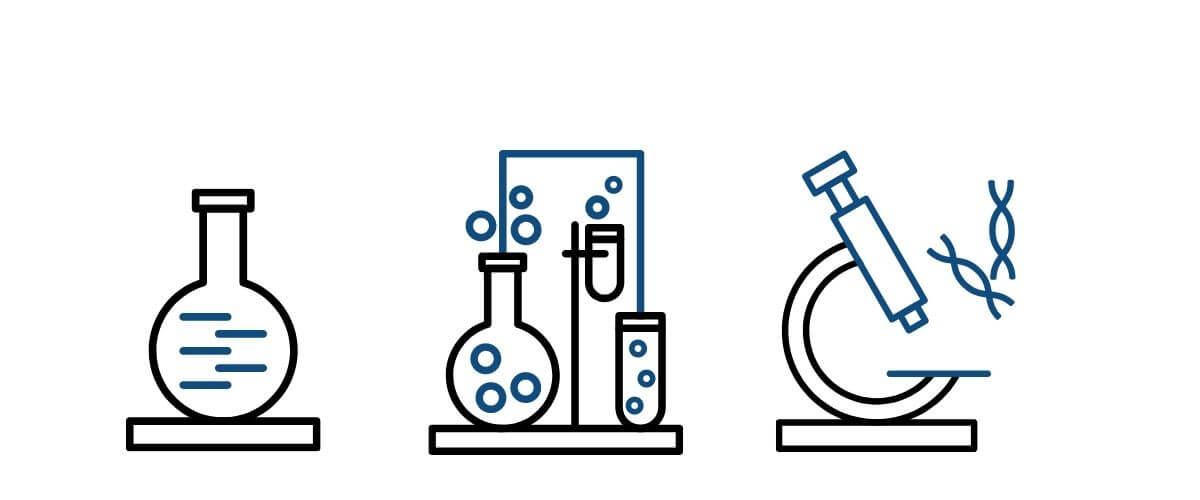
If you are in the process of designing a medical lab, there are several key factors you will need to consider. Here at OnePointe Solutions, we specialize in helping clients from virtually every industry to design and build custom laboratory solutions that fit their exact needs and have partnered with countless manufacturers, researchers, designers, and experts to create some of the best labs in the country.
Here, we’re sharing a few basic tips for what to consider during the medical lab design process and offering our advice for the best solutions to common medical lab needs.
What Is A Medical Lab?
A medical laboratory, sometimes called a clinical laboratory, is a laboratory where clinical specimens have tests carried out on them to obtain information about the health of a patient and to aid in the diagnosis, treatment, and prevention of disease. Medical laboratories vary in size and complexity, depending on the variety of testing services they offer.
The most comprehensive services can be found in acute-care hospitals and medical centers, where up to 70% of clinical decisions are based on laboratory testing. Doctors’ offices and smaller clinics, as well as skilled nursing and long-term care facilities, may have laboratories that provide more basic testing services, like basic blood chemistry tests.
Additionally, commercial medical laboratories operate as independent businesses and provide testing that is otherwise not provided in other settings due to low test volume or complexity.
Ideal Lab Location
Many medical labs are set up in existing hospital buildings, but independent, standalone buildings are also an option. Some medical labs are attached to a hospital, while others receive samples from many locations and process them for different medical businesses. These labs may be in one building or spread across a small business campus, depending on the size of the lab.
If you have space that you want to convert to a medical laboratory, you will need to choose the location carefully.
- Location convenient to patients
- Low contamination from adjacent rooms
- Thermostatically controlled heat
- Access to water and drains for a sink
- Access to plumbing for a toilet area for sample collection
- Adequate electrical service
- Good lighting
If you are planning on setting up your medical lab in a hospital or other medical building, consider building it in a space adjacent to a waiting room on the ground floor if it is going to serve patients. If your lab is only receiving samples, this is not an issue.
But if your lab is going to be taking samples, you’ll want to be in a place that’s easy for patients to access.
Modifying your existing space for a lab is quite possible, and whether you’re starting from scratch or planning to renovate, OnePointe Solutions has the experience and lab design team necessary to complete any lab building project. We are well-versed in the design language of medical labs and pay utmost attention to safety demands.
Lab Areas
While your lab setup is highly customizable based on your needs, all medical labs have certain requirements for lab design. Most medical labs have areas for specimen collection, accessioning and labeling, anatomical pathology, clinical pathology, and potentially molecular pathology depending on the size of the lab.
Specimen Collection, Accessioning, and Labeling
If a lab collects its own specimens, there is an area for a phlebotomist or nurse to collect samples. This area should include chairs for patients and collectors, a desk for the collector, storage space for collection supplies, and a toilet cubicle if the lab processes urine samples.
Once the specimen has been collected here or elsewhere, it is sent to the laboratory for testing. This area functions as an administrative area and requires computer workstations, storage cabinets, and specialized refrigerated storage areas for the specimens.
Anatomical Pathology
The medical laboratory is usually divided into an anatomical pathology area and a clinical pathology area, each made up of multiple departments or subareas. Anatomical pathology involves studying the effects of disease on the structure of organs, tissues, and cells, and is usually divided into a cytology department and histology or gross anatomical pathology department.
Cytology involves the microscopic study of cells to detect cancer and other cellular abnormalities in fluids such as PAP smears, cerebrospinal fluid, urine, and blood. Pathologists and cytotechnologists usually work alongside each other to identify abnormal cells present in fluids.
Histology involves the gross examination and microscopic analysis of tissue specimens. The gross examination involves organs and surgical tissue biopsies being examined as a whole by being weighed, measured, and dissected.
The specimens are then prepared for microscopic analysis to identify cancers and other diseases.
Clinical Pathology
Clinical pathologists oversee and collaborate with medical laboratory scientists and technicians to analyze various bodily fluids in four main clinical areas: Clinical chemistry, hematology, microbiology, and transfusion services.
The clinical chemistry department is usually the largest part of a medical laboratory. It is responsible for many of the most common tests, including comprehensive metabolic panels, thyroid function studies, lipid panels, hormone and vitamin assays, and drug screens.
The hematology department is responsible for analyzing a patient’s blood and blood components. This part of the lab is responsible for detecting diseases like leukemia, anemia, and other diseases that affect the ratio of red blood cells, white blood cells, and platelets in a whole blood sample.
Hematology departments are also typically responsible for another liquid testing, such as sperm counts, and urinalysis.
The microbiology department tests for and identifies pathogenic microorganisms such as bacteria, viruses, fungi, and parasites that may cause disease in a patient. Here, specimens are cultured to isolate pure colonies of various pathogens that can be identified using methods like PCR or mass spectrometry.
Some of the most common tests done by the microbiology department of a medical lab include STD testing and rapid tests for strep and other common pathogens.
The last subdivision of clinical pathology is transfusion services. This is sometimes called immunohematology or “blood bank,” and it is the area of the medical lab that’s responsible for providing compatible blood components to patients for transfusion.
Not all medical labs will have this department; independent testing labs, for example, typically don’t need a blood bank. But all hospital labs maintain a blood bank.
Independent labs that focus primarily on transfusion services also exist, and primarily function to provide large quantities of transfusion blood to hospitals.
Molecular Pathology
In larger laboratories, molecular and genetic testing might be done in a separate branch of pathology known as molecular pathology. Molecular pathologists usually work with medical scientists in two main areas, cytogenetics, and molecular diagnostics.
Cytogenetic testing involves isolating and studying the structure of chromosomes to identify a variety of chromosomal abnormalities that may lead to genetic defects such as Downs syndrome and Kleinfelter syndrome, as well as identifying certain intersex conditions. Molecular diagnostics look for specific markers in DNA or RNA sequences.
Molecular diagnostics are used to detect gene variants that cause inherited disease or make patients more susceptible to cancers with a genetic component. These labs frequently work with amniotic fluid to detect these conditions as part of prenatal testing.
Safety Precautions
Medical laboratories work with a great number of pathological specimens, as well as various bodily fluids, including blood. Because of this and because of the risk of cross-contamination, great attention must be paid to maintaining an antiseptic environment.
You will need to sterilize your equipment regularly.
Medical lab work may include work with infectious material, so you will need to install fume hoods, HEPA filters, and at least one lead-lined sink. You will need to have biosafety principles in place and have a plan for disposing of medical waste (such as incineration).
Your lab will draw a lot of power due to the amount of cold storage necessary for sample preservation. An emergency generator should be available to operate essential equipment during power outages.
All computer equipment should have battery backups as well, due to the importance of not losing any patient information.
Lab Equipment
The equipment needed for a medical culture lab is complex and often must be made custom to your lab’s specifications. While units like drying racks and sinks can be purchased and installed outright, lab casework and cabinetry, as well as your countertops, microscope tables, and computer workstations may need to be manufactured to spec.
In addition to basic lab furniture like casework and lab benches, medical labs require computer workstations, refrigerated and frozen storage, microscope tables, dissection workbenches, a washing area including a sink and drying racks, laboratory glassware, drying racks, autoclaves, forced air ovens for drying lab glassware, storage for lab equipment and medical tools, precision balances, centrifuges, mass spectrometers, incubation chambers, chemical reagents and tests, dissection equipment, and a vast assortment of analytical instruments depending on what the lab is going to test for.
Storage is one of the most important parts of any medical lab. Medical samples are fragile and must be kept in biosecure and temperature-controlled conditions.
You will need plenty of refrigerators, deep freezers, and potentially even liquid nitrogen freezers depending on the type of samples your lab will store.
At OnePointe Solutions, we are experts at building custom casework, countertops, lab tables, fume hoods, and other lab equipment that will improve your lab’s workflow and efficiency. The time and expense of customizing your lab equipment is worth it; with lab furniture that’s designed specifically for your lab’s needs, your lab’s operations will run smoothly and you will be able to feel secure and satisfied knowing that everything in your lab is top of the line and guaranteed to perform beyond expectations.
Need Helping Designing Your Medical Lab?
OnePointe Solutions is a leading laboratory construction and design firm, scientific furniture manufacturer, and lab builder. Our project history ranges from classrooms to Biosafety Level 3 and 3+ enhanced labs. No lab project is too small or too large for our expert design team.
Contact us by form or call us at (866) 612-7312 to get an estimate on furniture or full lab design and renovation today!


